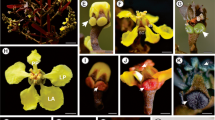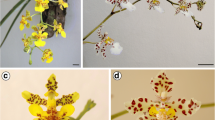Abstract
Staminal glands are an important character in the taxonomy of several Malpighiaceae genera, such as Banisteriopsis, Byrsonima, Diplopterys, Peixotoa and Stigmaphyllon, but only recently few studies started to elucidate the anatomy and ecological functions of these glands. Most genera showing staminal glands are placed in the Stigmaphylloid clade, one of the ten major lineages recovered in recent phylogenies for Malpighiaceae. Here, we identified the nature of the staminal glands from 25 Stigmaphylloid species aiming to characterize their micromorphology, anatomy and exudate histochemistry. Scanning electron and light microscopy were applied to examine the stamens of fresh collected or herborized flowers. All Stigmaphylloid representatives showed elaiophores, osmophores or both glands comprising the epidermal cells in the connective, anther or both regions of the stamen. Elaiophores were distinct into three structural patterns: (1) trichomatous, (2) secretory globose epidermis (3) and overlapping globose epidermal cells. These glands were identified mainly by the occurrence of fatty acids composing the secretion within the cells. Osmophores were always identified as unicellular papillae. Elaiophores and osmophores in the stamen seems to be homoplastic in Malpighiaceae, identified in the Stigmaphylloid clade and in the outgroup representative Byrsonima spicata. Osmophores were restricted to the connectives of Camarea and Cottsia, and at different positions in the anther epidermis of Byrsonima spicata, probably linked to their unique pollination syndromes. This is the first effort in understanding the evolutionary patterns of these glands in Malpighiaceae and should shed light on further studies comprising the remaining lineages of this family.





Similar content being viewed by others
References
Alves-dos-Santos I, Machado IC, Gaglianone MC (2007) História natural das abelhas coletoras de óleo. Oecol Brasil 11:544–557
Ambruster WS (1984) The role of resin in Angiosperm pollination: ecological and chemical considerations. Amer J Bot 71:1149–1160. https://doi.org/10.1002/j.1537-2197.1984.tb11968.x
Anderson WR (1975) The taxonomy of Acmanthera (Malpighiaceae). Contr Univ Michigan Herb 11:41–50
Anderson WR (1979) Floral conservatism in Neotropical Malpighiaceae. Biotropica 11:219–223
Anderson C (1982) A monograph of the genus Peixotoa (Malpighiaceae). Contr Univ Michigan Herb 15:1–92
Anderson WR (1987) Notes on Neotropical Malpighiaceae. Contr Univ Michigan Herb 16:55–108
Anderson C (1995) Revision of Thryallis (Malpighiaceae). Contr Univ Michigan Herb 25:137–166
Anderson CE (1997) Monograph of Stigmaphyllon (Malpighiaceae). Syst Bot Monogr 51:1–313
Anderson WR, Davis CC (2007) Generic adjustments in Neotropical Malpighiaceae. Contr Univ Michigan Herb 25:137–166
Araújo JS, Meira RMSA (2016) Comparative anatomy of calyx and foliar glands of Banisteriopsis C. B. Rob. (Malpighiaceae). Acta Bot Brasil 30:112–123. https://doi.org/10.1590/0102-33062015abb0248
Bruneton J (1999) Pharmacognosy: phytochemistry medicinal plants, 2nd edn. Intercept, Hampshire
Buchmann SL (1987) The ecology of oil flowers and their bees. Annual Rev Ecol Syst 18:343–369. https://doi.org/10.1146/annurev.es.18.110187.002015
Buzgo M, Chanderbali AS, Kim S, Zheng Z, Oppenheimer DG, Soltis PS, Soltis DE (2007) Floral developmental morphology of Persea americana (Avocado, Lauraceae): the oddities of male organ identity. Int J Pl Sci 168:261–284. https://doi.org/10.1086/510297
Cai L, Peterson K, Rushworth C, Beaulieu J, Davis CC (2016) Phylogeny of Elatinaceae and the tropical Gondwanan origin of the Centroplacaceae (Malpighiaceae, Elatinaceae) clade. PLoS ONE 11:e0161881. https://doi.org/10.1371/journal.pone.0161881
Carvalho PD, Borba EL, Luchese AM (2005) Variação no número de glândulas e produção de óleo em flores de Stigmaphyllon paraliasA.Juss. (Malpighiaceae). Acta Bot Brasil 19:209–214. https://doi.org/10.1590/S0102-33062005000200002
Castro MA, Vega AS, Múlgura ME (2001) Structureandultrastructureofleafandcalyxglands in Galphimia brasiliensis (Malpighiaceae). Amer J Bot 88:1935–1944. https://doi.org/10.2307/3558420
Cocucci AA, Holgado AM, Anton AM (1996) Estúdio morfológico y anatômico de loseleóforos pedicelados de Dinemandra ericoides, Malpighiácea endêmica Del desierto de Atacama, Chile. Darwiniana 34:183–192. https://doi.org/10.14522/darwiniana.2014.341-4.404
Davis CC, Anderson WR (2010) A complete generic phylogeny of Malpighiaceae inferred from nucleotide sequence data and morphology. Amer J Bot 97:2031–2048. https://doi.org/10.3732/ajb.1000146
Davis CC, Schaefer H, Xi Z, Baum DA, Donoghue MJ, Harmone LJ (2014) Long-term morphological stasis maintained by a plant–pollinator mutualism. Proc Natl Acad Sci USA 111:5914–5919. https://doi.org/10.1073/pnas.1403157111
De-Paula OC, Sajo MG, Prenner G, Cordeiro I, Rudall PJ (2011) Morphology, development and homologies of the perianth and floral nectaries in Croton and Astraea (Euphorbiaceae-Malpighiales). Pl Syst Evol 292:1–14. https://doi.org/10.1007/s00606-010-0388-9
Dobson HEM (2006) Relationship between floral fragrance composition and type of pollinator. In: Dudareva N, Pichersky E (Eds.), Biology of Floral Scent. Taylor & Francis Group, Boca Raton
Dötterl S, Schäffler I (2007) Flower scent of floral oil-producing Lysimachiapunctata as attractant for the oil-bee Macropisfulvipes. J Chem Ecol 33:441–445. https://doi.org/10.1007/s10886-006-9237-2
Endress PK (1994) Diversity and evolutionary biology of tropical flowers. Cambridge University Press, Cambridge
Fahn A (1988) Secretory tissues in vascular plants. New Phytol 108:229–257. https://doi.org/10.1111/j.1469-8137.1988.tb04159.x
Fahn A (2000) Structure and function of secretory cells. Advances Bot Res 31:37–75. https://doi.org/10.1016/S0065-2296(00)31006-0
Feder N, O’brien TP (1968) Plant microtechnique: some principles and new methods. Amer J Bot 55:123–139. https://doi.org/10.2307/2440500
Ganter P, Jolles G (1969) Histochimienormale et pathologique. Gautier Villars, Paris
Gates B (1982) Banisteriopsis and Diplopterys (Malpighiaceae). Fl Neotrop Monogr 30:1–237
Gregory M, Baas P (1989) A survey of mucilage cells in vegetative organs of the dicotyledons. Israel J Bot 38:125–174. https://doi.org/10.1080/0021213X.1989.10677119
Guimarães E, Di Stasi LC, Maimoni-Rodella RCS (2008) Pollination biology of Jacaranda oxyphylla with an emphasis on staminode function. Ann Bot (Oxford) 102:699–711. https://doi.org/10.1093/aob/mcn152
Jeger RN, Lichtenfeld Y, Peretz H, Shany B, Vago R, Baranes D (2009) Visualization of the ultrastructural interface of cells with the outer and inner surface of coral skeletons. J Electr Microscopy 58:47–53. https://doi.org/10.1093/jmicro/dfp005
Johansen DA (1940) Plant michrotechnique. McGraw-Hill, New York
Johnson DM (1986) Revision of the Neotropical genus Callaeum (Malpighiaceae). Syst Bot 11:335–353. https://doi.org/10.2307/2419124
Kivimäenpää M, Jonsson AM, Stjernquist I, Sellden G, Sutinen S (2004) The use of light and electron microscopy to assess the impact of ozone on Norway spruce needles. Environm Pollut 127:441–453. https://doi.org/10.1016/j.envpol.2003.08.014
Lobreau-Callen D (1989) Les Malpighiaceae et leurspollinisateurs. Coadaptationoucoévolution. Bull Mus Natl Hist Nat B Adansonia 11:79–94
McManus JFA (1948) Histological and histochemical uses of periodic acid. Stain Technol 26:99–108
Mello MAR, Bezerra ELS, Machado IC (2013) Functional roles of Centridini oil bees and Malpighiaceae oil flowers in biome-wide pollination networks. Biotropica 45:45–53. https://doi.org/10.1111/j.1744-7429.2012.00899.x
Moyano F, Cocucci A, Sérsic A (2003) Accessory pollen adhesive from glandular trichomes on the anthers of Leonurussibiricus L. (Lamiaceae). Pl Biol (Stuttgart) 5:411–418. https://doi.org/10.1055/s-2003-42707
Neff JL, Simpson BB (1981) Oil-collecting structures in the Anthophoridae (Hymenoptera): morphology, function, and use in systematics. J Kansas Entomol Soc 54:95–123
Pansarin LM, Castro MM, Sazima M (2009) Osmophores and elaiophores of Grobya amherstiae (Catasetinae, Orchidaceae) and their relation to pollination. Bot J Linn Soc 159:408–415. https://doi.org/10.1111/j.1095-8339.2009.00953.x
Pizzolato TD (1977) Staining of Tiliamucilages with Mayer’s tannic acidferric chloride. Bull Torrey Bot Club 104:277–279. https://doi.org/10.2307/2484311
Possobom CCF, Machado SR (2017) Elaiophores in three Neotropical Malpighiaceae species: a comparative study. Pl Syst Evol 304:15–32. https://doi.org/10.1007/s00606-017-1443-6
Possobom CCF, Guimarães E, Machado SR (2010) Leaf glands act as nectaries in Diplopterys pubipetala (Malpighiaceae). Pl Biol (Stuttgart) 12:863–870. https://doi.org/10.1111/j.1438-8677.2009.00304.x
Possobom CCF, Guimarães E, Machado SR (2015) Structure and secretion mechanisms of floral glands in Diplopterys pubipetala (Malpighiaceae), a Neotropical species. Flora 211:26–39. https://doi.org/10.1016/j.flora.2015.01.002
Reis MG, de Faria AD, Alves-dos-Santos I, Amaral MCE, Marsaioli AJ (2007) Byrsonic acid—the clue to floral mimicry involving oil-producing flowers and oil-collecting bees. J Chem Ecol 33:1421–1429. https://doi.org/10.1007/s10886-007-9309-y
Renner SS, Schaefer H (2010) The evolution and loss of oil-offering flowers: new insights from dated phylogenies for plants and bees. Philos Trans Roy Soc London 365:423–435. https://doi.org/10.1098/rstb.2009.0229
Ronse De Craene LP, Smets EF (2001) Staminodes: their morphological and evolutionary significance. Bot Rev (London) 67:351–402. https://doi.org/10.1007/BF02858099
Rudall PJ, Stevenson DW, Linder HP (1999) Structure and systematics of Hanguana, a monocotyledon of uncertain affinity. Austral Syst Bot 12:311–330. https://doi.org/10.1071/SB97042
Schäffler I, Balao F, Dötterl S (2012) Floral and vegetative cues in oil-secreting and non-oil-secreting Lysimachia species. Ann Bot (Oxford) 110:125–138. https://doi.org/10.1093/aob/mcs101
Simões CMO, Schenkel EP, Gosmann G, Mello JCP, Mentz LA, Petrovick P (2004) Farmacognosia: da planta aomedicamento, 5tha edn. Editora da UFSC, Florianópolis
Simpson BB (1989) Pollination biology and taxonomy of Dinemandra and Dinemagonum (Malpighiaceae). Syst Bot 14:408–426
Simpson BB, Neff JL (1981) Floral rewards: alternatives to pollen and nectar. Ann Missouri Bot Gard 68:301–322
Smets EF, Ronse De Craene LP, Caris P, Rudall PJ (2000) Floral nectaries in monocotyledons: distribution and evolution. In: Wilson KL, Morrison DA (eds) Monocots–systematics and evolution. CSIRO, Melbourne
Smith FH, Smith EC (1942) Anatomy of the inferior ovary of Darbya. Amer J Bot 29:464–471. https://doi.org/10.2307/2437312
Torretta JP, Aliscioni SS, González-Arzac A, Avalos AA (2018) Is the variation of floral elaiophore size in two species of Stigmaphyllon (Malpighiaceae) dependent on interaction with pollinators? Pl Ecol Diversity 10:403–418. https://doi.org/10.1080/17550874.2018.1434567
Vinson SB, Williams HJ, Frankie GW, Shrum G (1997) Floral lipid chemistry of Byrsonima crassifolia (Malpighiaceae) and a use of floral lipid by Centrisbees (Hymenoptera: Apidae). Biotropica 29:76–83. https://doi.org/10.1111/j.1744-7429.1997.tb00008.x
Vogel S (1974) ÖlblumenundölsammelndeBienen. Trop Subtrop Pflanzenwelt 7:283–547
Vogel S (1990) History of Malpighiaceae in the light of pollination ecology. Mem New York Bot Gard 55:130–142
West-Eberhard MJ (2003) Developmental plasticity and evolution. Oxford University Press, Oxford
Acknowledgements
We thank the staff and curators of all herbaria, especially the Smithsonian Institution, for their assistance in getting stamen samples, CAPES (Finance Code 001) for the postdoctoral scholarship granted to RFA, CNPq for partial funds (Grant # 422747/2016–5), FAPESP for the scholarships granted to GAR and PCG, Central Analitica (CEM-UFABC) for SEM assistance and the Smithsonian Institution for the Cuatrecasas Award to RFA.
Author information
Authors and Affiliations
Corresponding author
Ethics declarations
Conflict of interest
The authors declare that they have no conflict of interest.
Human and animal rights
This research did not include human participants or any animals.
Additional information
Handling Editor: Louis P. Ronse De Craene.
Publisher's Note
Springer Nature remains neutral with regard to jurisdictional claims in published maps and institutional affiliations.
Rights and permissions
About this article
Cite this article
Arévalo-Rodrigues, G., de Almeida, R.F. & Cardoso-Gustavson, P. Anatomy of staminal glands in the Stigmaphylloid clade sheds light into new morphotypes of elaiophores and osmophores in Malpighiaceae. Plant Syst Evol 306, 56 (2020). https://doi.org/10.1007/s00606-020-01680-w
Received:
Accepted:
Published:
DOI: https://doi.org/10.1007/s00606-020-01680-w




